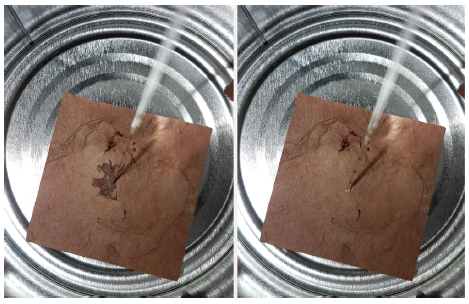
As both a proud and loving owner of a loyal golden doodle (Fezzik) and an analytical chemist, I couldn’t resist this one! I also can’t resist posting a photo of our family’s lovable hot dog burglar, Fezzik. He’s in his winter attire in this photo from last Saturday morning’s breezy -34°C walk. He’s amazingly well adapted to the cold, with enough circulation to keep his exposed nose and thin ears nice and warm no matter what!
But I digress. Did you know that man’s best friend is an analytical chemistry superhero? Well, I guess we are all familiar with the notion that dogs have incredibly sensitive noses. We may have seen handlers harnessing their dog’s superpower for good, such as with drug sniffer dogs at airports and accelerant sniffer dogs at arson crime scene. A dog/hander team photo of German Sheppard Ezra and Jeff Lunder of CADA Fire Dogs from the Harynuk paper described below is shown below.

It should perhaps come as no surprise that there’s some really cool biology behind their abilities. Chemist and founder of Chemistry Matters Dr. Court Sandau recently posted a link on LinkedIn to an excerpt of a talk he gave describing the special design of canine olfactory systems – have a look. Dogs have 300 million sensing cells (~50x as many as humans), direct over 10% of their inhaled air over these sensors, and can expand the area at will to allow for expanded sensitivity … absolutely fascinating!
It may come as a surprise, however, to learn that their olfactory power is more sensitive than the best analytical chemistry methods and instrumentation, and that this actually causes us problems as they work their magic. The dilemma arises when a forensic lab cannot detect the presence of an accelerant that a dog very likely correctly identified, due to the lab’s inferior limit of detection (LoD, the lowest amount or concentration for which something can be detected by a dog, detector, etc.); such a situation can potentially render arson evidence inadmissible.
A paper published in Forensic Chemistry last year by Professor James Harynuk’s group at the University of Alberta tackled the first step in addressing the gap between canine and analytical instrumentation/methodology performance: determining the canine limit of detection for an accelerant. With an idea of dogs’ capabilities, analytical chemists would at least know the target they are trying to hit!

A great deal of effort was required by Harynuk’s group to conceive of and validate methods to clean and prepare slate tile substrates to receive accelerant samples; the extent of initial contaminants and cleaning effectiveness was demonstrated with solid phase microextraction followed by gas chromatographic – mass spectrometry headspace analysis. They also had to research and chose suitable solvents and stabilisers in which to prepare diluted accelerant solutions. Taking great care to eliminate any source of bias for the dog and handler during the identification trials, Harynuk’s team applied an increasingly diluted range of accelerants such as lighter fluid, regular gasoline and diesel gasoline, to slate tile substrates located amongst blank and control tile samples with other petroleum components typical of a scene. An example of a sample being applied to a tile substrate is shown at right. For the trials, two dog/handler teams were brought in to determine their ability to correctly identify the spiked tile from the group, and at increasingly weaker doses. Both dog/handler teams were able to correctly detect tiles spiked with as little as 5 pL of gasoline (1 pL is one billionth of 1 mL)!
And so now we know why it is that, when we quietly peel the film wrap off steaks to be prepared for the grill, our dog smells it from the other end of the house, two stories up, and comes running with eyes full of hope and obedience … before the first dash of steak spice has hit the meat!
